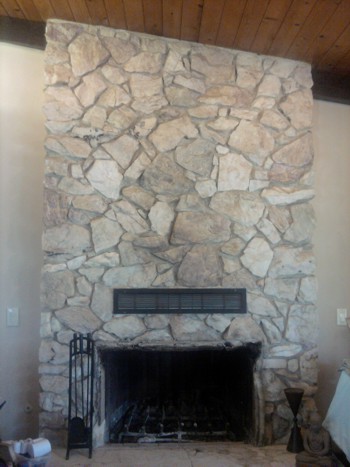Fireplace Repair Options
DEAR TIM: I have an old rock fireplace that I hate. The built-in heat-a-lator has also stopped working. I want to change the rock face to one that’s wood. I have some extensive woodworking experience, so is it possible to make these fireplace repairs myself? Can I build a wood frame over the rock and disconnect the gas log lighter that’s in the firebox? Suzanne H., Richmond, VA
DEAR SUZANNE: This fireplace restoration is an enormous job. I always say that anything is possible if you have enough resources, which sometimes includes lots of money. This job, however, needs abundant skill, time and a deep knowledge of the building code.

The homeowner wants to transform the rock face into wood. It’s a daunting task fraught with problems. PHOTO CREDIT: Suzanne Hofer
The quick answer is that it’s possible to do what you want. You can transform the exterior look of the fireplace. But I’d caution you about removing the gas log lighter. A future homeowner may want this convenience.
If you’ve ever seen how many masonry fireplaces are constructed, you’d immediately think of the way cars were built before the advent of unibody construction. Cars used to be built like trucks are today. There was a chassis or frame and the body skin of door panels, fenders, quarter panels, etc. all were bolted to one another then to the frame.
Fireplaces are somewhat like this. Modern masonry fireplaces often have a concrete block center core that contains the clay flue liners and the firebox made with high-temperature fire brick. The outer skin you see can be rock, brick, wood, plaster, drywall, etc. These materials are attached to the concrete-block center core.
Your challenge is to see what’s easier assuming you have a masonry fireplace that constructed with a block core: Remove the rock facing or build a code-approved wood frame out beyond the rock.
If you decide to attach your finished wood to a wood frame that’s attached to the rock, be aware the thickness of the wood frame and finished wood skin may cause the firebox starts to get deeply recessed into the overall fireplace. There could be an aesthetic dimension here that needs to be addressed. It could also be a building code issue.
Before you do one thing, you need to visit your local building department and get a copy of the current building code. Take photos with you and meet with the building inspector or the head of the building department. Remember, these are public employees and are our servants. It’s their job to assist you and answer your questions.
You want to be crystal clear on all the clearances that are mandated in the code with respect to the proximity of combustible materials to the firebox. Don’t leave this meeting unless you completely understand what the minimum requirements are. Make drawings there and have the building inspector sign them or otherwise approve your understanding.
You’ll discover quickly that the code talks about horizontal and vertical distances to things that burn. It also may have a section that talks about maximum overhang of combustible materials.
Once you have a firm understanding of these code requirements, take the time to draw a simple scale plan of what you’re allowed to do. See if is going to look right. You want to make sure you also do a side elevation as if you’re looking at the fireplace sideways. This will be on a scale that measures perhaps 1 inch equals 1 foot. You only need to draw from the hearth up to about 3 feet above the mantel. This will give you a good idea of the mass of the new exterior skin.
As for the heat-a-lator, you’ll have to determine if the fans are bad or if it’s some other electrical problem. If there are no fans and it’s just a gravity air convection system, perhaps you can determine why there is no or little airflow as you take apart the fireplace. It could have been poorly designed from the get go, and there may be little hope of making it work without a massive reconstruction effort.
You’ll have to incorporate a new stone material that surrounds the firebox and transforms to the wood. You may choose to use a natural stone like marble or granite for this. You can also use ceramic tile. We had one fireplace at our last home that had a green serpentine marble surround that complimented the walnut wood surround. Our living room fireplace had a traditional decorative ceramic tile facade just outside of the firebox.
All of these treatments usually need perfectly smooth surfaces to bond the tile or the stone to the fireplace core. You’ll have to engineer all of this into your plan before you start the job. This may require you to tear off all the stone to get to the central core of the fireplace. Be prepared to punt frequently as you’re entering unknown territory.
If you decide to build a frame on top of the rock, I’d strongly consider using lightweight steel studs. These don’t burn. If you need to add lumber to make nailing or screwing your finished wood to the frame easier, be sure to used fire-rated lumber that’s cut to fit into the steel stud channels. You can often find commercial-grade fire-rated lumber at specialty lumber yards. It’s been chemically treated so it doesn’t support flame except under the most fierce fire conditions.
You want to do everything possible to ensure an ember that could somehow get behind the finished wood doesn’t set the frame on fire as you leave the room unattended. Steel is your best bet.
Column 877